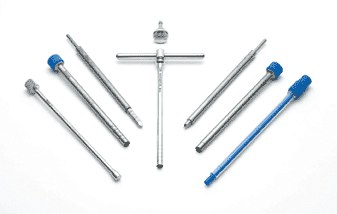Chondral osseous replacement improved femoral defects
Advantage of the technique is that it provides immediate arthroscopic solution.
![Arthroscopy Association of North America - AANA [logo]](/~/media/images/news/print/orthopedics-today/2004/06_june/aana_150_65_1782.gif) ORLANDO,
Fla. — Use of the chondral osseous replacement technique for
full-thickness femoral defects has resulted in no increase in total femoral
symptoms and no arthritic changes at 48 months’ follow-up.
ORLANDO,
Fla. — Use of the chondral osseous replacement technique for
full-thickness femoral defects has resulted in no increase in total femoral
symptoms and no arthritic changes at 48 months’ follow-up.
“Grafting lesions equal to or less than 2.5 cm in diameter provided clinical improvement,” said F. Alan Barber, MD, Plano Orthopedic and Sports Medicine Center, Texas. “The benefits were maintained over time,” he said during a presentation at the Arthroscopy Association of North America 23rd Annual Meeting.
Barber and colleague James C. Y. Chow, MD, reviewed the clinical and radiographic results of chondral osseous replacement (COR, DePuy Mitek) from a prospective study of full-thickness articular cartilage lesions begun in 1995. Their inclusion criteria were femoral condyle defects between 1 cm and 3.5 cm in diameter in stable, nonarthritic knees. Only patients with a minimum of 24 months’ follow-up were included, with an average follow-up of 48 months.
Patients with generalized chondral damage, arthritis, infection, multiple lesions or intraarticular fractures were excluded.
The average age of the 39 patients who met the inclusion criteria was 45 years (20 men, 19 women). Thirty cases involved the medial femoral condyle; nine, the lateral femoral condyle.
“Full-thickness defects on the femoral condyle are often found unexpectedly,” Barber said. “The advantage of the COR technique is that you provide an immediate arthroscopic solution using an outpatient technique that has good graft availability.”
The steps of the procedure begin with preparing the site by making a wall around the periphery of the lesion, then determining the number of grafts that are needed to fill the defect. After that, the recipient holes are drilled.
“This is different from the other procedures out there because [the COR system uses] a drill that gives you a finite depth.”
|
COURTESY OF DEPUY MITEK |
In their study, Barber and his colleagues used the intercondylar notch as the harvest site. “It has easy access, and there is proven donor site healing that gives you the opportunity to use the backfill prostheses that are becoming available.
“Our postoperative protocol calls for immediate motion, nonweight-bearing for three weeks, progressive weight-bearing for three to six weeks, then full weight-bearing after six weeks from insertion,” he said.
The Lysholm scores improved from 43 to 84 and the postoperative Tegner score was 4.9.
The researchers performed biopsies in 36% of these at various intervals out to 12 months. A histology done using a bone biopsy needle showed living articular cartilage and normal, living osteocytes.
“We found that the donor sites filled without grafts, there was no extension into the adjacent area but it was sort of a sunken, fibrocartilaginous scar. … Filling this with a backfill prosthesis might be a better idea,” Barber said.
Radiographically, there were no changes from the preoperative status at an average of 48 months.
“The reason that this seems to be successful … is that we strictly adhere to the inclusion criteria. We use only 6-mm plugs and not larger. We have a constant-depth harvester and we take only from the intercondylar notch.”
For more information:
- Barber FA, Chow JCY. Chondral osseous replacement (COR technique) for femoral defects. Presented at the Arthroscopy Association of North America 23rd Annual Meeting. April 22-25, 2004. Orlando, Fla.

